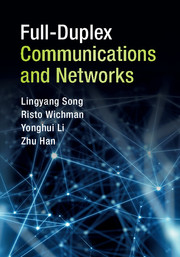Book contents
- Frontmatter
- Dedication
- Contents
- Preface
- 1 Basics of Communication Systems
- 2 Signal Processing and Theoretical Limits
- 3 Full-Duplex System Hardware Implementation
- 4 Full-Duplex MIMO Communications
- 5 Full-Duplex OFDMA Communications
- 6 Full-Duplex Heterogeneous Networks
- 7 Full-Duplex Cooperative Networks
- 8 Full-Duplex Cognitive Radio Networks
- 9 Full-Duplex Random Access Networks
- References
- Index
4 - Full-Duplex MIMO Communications
Published online by Cambridge University Press: 16 March 2017
- Frontmatter
- Dedication
- Contents
- Preface
- 1 Basics of Communication Systems
- 2 Signal Processing and Theoretical Limits
- 3 Full-Duplex System Hardware Implementation
- 4 Full-Duplex MIMO Communications
- 5 Full-Duplex OFDMA Communications
- 6 Full-Duplex Heterogeneous Networks
- 7 Full-Duplex Cooperative Networks
- 8 Full-Duplex Cognitive Radio Networks
- 9 Full-Duplex Random Access Networks
- References
- Index
Summary
Thanks to the various state-of-the-art approaches for self-IC schemes, SI is no longer a critical bottleneck when implementing a practical FD system. In this chapter, we introduce FD MIMO communications, including some key techniques and some performance analysis. The FD MIMO advantages can be summarized as: efficient and flexible utilization of wireless communication resources; increasing the capacity of the communication networks; and guaranteeing reliable communication. These have all become crucial claims for the next generation of cellular networks. Full Duplex (FD) is a very promising technique that allows for efficient use of wireless communication resources, given that the self-interference level can be suppressed to an acceptable level.
In the following, we describe a few signal processing techniques of the FD MIMO system where two nodes bidirectionally communicate with each other. Firstly, we describe the mode switching between FD and half-duplex spatial-multiplexing (HDSM). By configuring the antennas as either transmit or receive antennas, the MIMO system can be configured as either an FD system or an HD-SM system; these are considered two important techniques for improving the spectral efficiency of MIMO systems. FD transmission suffers from self interference, while the performance of an SM system is greatly affected by spatial correlation. Therefore, there is an optimal trade-off between FD and SM, depending on the system setting and channel conditions. Then, we introduce the antenna pairing strategy, where each node is equipped with two antennas, used for either transmission or reception. Specifically, one transmit and receive antenna combination is selected based on two system performance criteria: 1) maximum sum-rate (Max-SR), and 2) minimum symbol-error-rate (Min-SER). We further extend our strategy to the scenario where each node is equipped with an arbitrary number of antennas. We describe bidirectional link selection schemes by selecting a pair of transmit and receive antenna at both ends for communications in each direction, to maximize the weighted sum-rate or minimize the weighted sum SER. Then, we introduce an X-Duplex scheme, where the antenna is adaptively configured based on the channel conditions. The X-Duplex scheme aims to maximize the instantaneous sum-rate of the system. Finally, we conclude this chapter and discuss some of the key challenges in FD MIMO communications.
FD MIMO Signal Processing
Mode Switching between Full-Duplex and Half-Duplex
Typically, there are two kinds of baseline for FD and HD mode switching: a fixed number of antennas and a fixed number of RFs.
Information
- Type
- Chapter
- Information
- Full-Duplex Communications and Networks , pp. 109 - 137Publisher: Cambridge University PressPrint publication year: 2017
